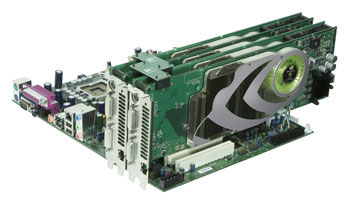Introduction

NVIDIA recently announced Quad SLI at CES, partnering with Dell to show the four GPU extension of their SLI technology to a waiting world. SLI, or Scaleable Link Interface, is NVIDIA's method of combining more than one GPU in a computer system in order to accelerate 3D rendering.
The first generation of SLI consisted of a pair of NV45 or NV43 GPUs on NVIDIA nForce or Intel workstation class PCI Express core logic, with the GPUs on their own discrete boards, connected via an inter-card link. Driver support layered on top of those technology pieces, working with the two GPUs per application to accelerate rendering. Various rendering modes were offered and in general it worked well off the bat.
Time has seen the technology mature in terms of driver support, with recent ForceWare releases giving you SLI profiles for hundreds of games, mismatched vendor support to combine cards from say Galaxy and XFX, and the ability to tweak SLI yourself for games you might own that the driver isn't aware of.
The core logic to support SLI has moved on a step, too. True dual PEG16X mainboards exist now, allowing each card a full 16-lane link to the root host, whereas the first implementations of SLI saw cards share a 16-lane link, splitting it into two 8-lane portions.
All in, it's an appealing way to increase 3D performance, whether you're an upgrader or someone seeking the utmost 3D performance possible. Of course it also has its downsides, be they driver related, physical or environmental, but it seems that on the whole, users are happy with it and are buying SLI technology in numbers that NVIDIA weren't anticipating. Every time I talk to the IHV about the technology and how it's going for them, they can't enthuse enough.
I wrote at the time of launch that, "it's possible (in future iterations of SLI) to use more than just two graphics cards in the system", and Quad SLI proves that right.
This piece gets some of the Quad SLI details out of the way before it officially launches at GDC 2006. So there's no performance data in this article - at least not yet - so avert your eyes now if you don't care about how Quad SLI will work in a technical sense. It's all about the theory here, I'm afraid!










